Renaissance Armies: The Irish
An article by George Gush
 Until the rebellion of Shane O'Neill in the 1560s, the Irish indulged in constant raiding and ambushing, frequently of each other, occasionally fought a single battle, but did not really fight wars. From 1561 to 1603, however, there were a series of campaigns against the English, culminating in that of Tyrone, which was on a really large scale. Until the rebellion of Shane O'Neill in the 1560s, the Irish indulged in constant raiding and ambushing, frequently of each other, occasionally fought a single battle, but did not really fight wars. From 1561 to 1603, however, there were a series of campaigns against the English, culminating in that of Tyrone, which was on a really large scale.
In the early part of the 16th Century the warriors of Ireland were very traditional in armament and tactics, but as the wars continued more up-to-date weapons made their appearance and some full scale battles were fought, though the traditional "guerrilla-type" tactics were more successful, as in the Irish victory of the Yellow Ford, 1598.
The Irish made good use of difficult country and of field fortifications, digging trenches and "plashing" trees into impenetrable barriers, often in connection with an ambush.
Traditional Types
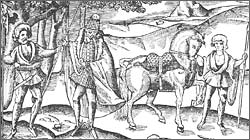
An Irish chief, probably in a type of brigantine, prepare to mount for a raid
(British Library)
|
The Gallowglass
These were originally Scots mercenaries, but by the 16th Century their clans or "septs" had often been settled in Ireland for two or three centuries (the most famous were the MacDonalds and the McSweeneys); they were still mercenaries, but often owed loyalty to a particular noble (in fact in 1568 there were three septs of the "Queen Majesty's Galloglasses"). They usually wore an iron bascinet, and either a mail shirt or a short cape of mail over a padded quilted coat called a "cotun" and their characteristic weapon was a heavy two-handed axe, up to six feet long, which could chop the enemy's head off with a single blow (it was still used in 1588 when McLaghlin M'Cabb killed 80 Spaniards from the Armada with one).
Gallowglasses were organized in "battles" of 80 or 87 men, but each gallowglass was accompanied by two boys, who carried his supplies, armour, and his secondary weapons, three light Irish javelins or "darts".
The Kern
The ordinary Irish foot soldiers, made up partly of "bonnachts", or Irish mercenaries maintained by the various nobles, and partly of free peasantry called out to fight. The bonnachts might sometimes be dressed like the gallowglasses, or else like the rising-out, as the peasants were called; that is, no armour, simply the traditional Irish dress of a linen tunic with very wide sleeves, often dyed yellow with saffron, usually worn over tight trews of a plain color, and sometimes covered with a very short coat of goat's hair or a large mantle or "shag-rug", patterned, and with a long fringe of "an agreeable mixture of colors".
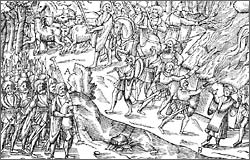
This print from John Derrick's "The Image of Ireland" (1581) shows Ulster Kern indulging in their usual raiding. The particular type of jacket worn, with pleated "frill", is probably an Ulster variation. At lower left the men with long axes are probably bonnachts. Note the bagpiper. (British Library)
|
Bonnachts might have been armed with the sparth-axe, but the usual weapons were javelins or "darts" of which each kern had a handful; even the English admitted that the Irish were extraordinarily skilled with this weapon, but said it was "More Noisesome, especially to the Horse, than deadly".
A few of the kern also used the bow, and a sword or spear and shield might be carried; the shields were oval and convex, of wood or basket-work. Each man would also carry a "skean" or long dagger. They were often clean-shaven but wore flowing moustaches and a mop of shaggy hair or "glib" falling over the forehead (banned by the English as making it difficult to recognize their "thievish countenances").
Their tactics were normally those of skirmishers, especially in difficult country where, often, no other troops could move, but they could also charge fiercely in the right circumstances, clashing their weapons together with a loud cry of "Pharroh!" (Probably really "Faire"—"Watch out!"; anyone who didn't join in was popularly supposed to be wafted off to a mysterious valley in Kerry and Never Seen Again!). What they couldn't do was to stand up against cavalry in the open.
The Cavalry
A small proportion of the average Irish force, the cavalry would normally be made up of gentry. They were equipped with a helmet with a strange turned-up nasal, mail shirt, sword and shield, but their chief weapon was a longish light spear held in the middle and used over-arm either for stabbing or throwing, not couched as a lance. One reason for this was that the Irish, like their ancient forebears, still used neither stirrups nor a proper saddle (though their checked, pillow-like saddles may have had a wooden tree); another was that their light cobs could not stand up to the heavier English horses in a full charge.
They were thus mainly useful for scouting, skirmishing, or pursuit. In the earlier 16th Century the Irish seem to have had the unusual habit of drawing up the cavalry on the left of their battle line.
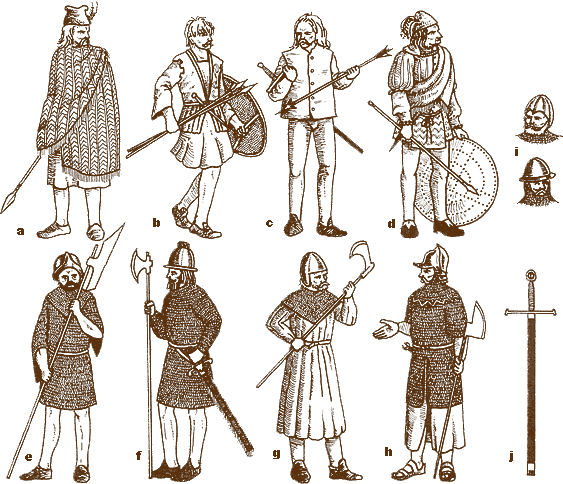
a. Irishman in mantle. Cap is of a type worn by Irish irregulars in Europe, b. Kern with "Skean", shield and darts. Tunic is simpler than the Ulster version shown in Derrick's prints. Note type of surcoat. c. Kern, early 17th Century. He wears a very short, loose coat of blue and tight hose (pinkish-red seems to be the usual color). He holds his sword under his right arm (the Irish are often shown holding sheathed swords, rather than having them slung from belts). In his left hand is a javelin, in this case having actual flights, like a modern dart. He wears dark leather brogues, d. Irish chieftain, 17th Century. He holds a black, gold mounted javelin in his right hand, and a shield (a large oval affair, covered in red leather and decorated with studs) in his left. His conical cap is of tooled red leather. He wears a slashed doublet with halt sleeves, the traditional fringed cloak and red hose, and a decorated "Erse apron", e. and f. A pair of Gallowglasses, both from sketches by G. A. Hayes McCoy. 'f' has a somewhat Scandinavian look and not surprisingly comes from a charter granted to Dublin in 1583. He has a typical sword and scabbard, tall helmet with small crest (?), and long-handled axe. 'e' comes from a map of 1567. Note baggy sleeves, mail cape, typically 15th Century bascinet, and seven-foot Lochaber axe. Both are barelegged, and could have been barefooted too. g. Gallowglass in "cotun", mail cape and helmet, h. Gallowglass in mail cape and skirt and cavalry-style helmet. Note different shape of axe (based on a Durer drawing), i. Two alternative Gallowglass helmets. The upper drawing depicts a 15th Century padded type, j. Typical Irish 16th Century sword. Note ring at base of hilt with tang passing through it, and square-ended scabbard. Irish swords of this period were usually straight, and large. The accompanying Derrick prints show alternative scabbard types, especially those with a dagger strapped to the outside of the scabbard.
Irish Flags
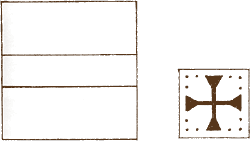
Flags shown in a print of the Irish force at the battle of Erne Fords in 1593. Infantry flag on left, cavalry on right. Colors not known. The cavalry flag may be an "Irish Cross". Something similar in red on white was carried by the 17th Century Catholic Confederates.
|
The cross of St. Patrick was not apparently considered as a symbol of Ireland at the time. Two "national" flags which may have been used in the 16th Century are a blue flag with three gold crowns, and the traditional Irish harp in gold, probably then on a blue ground.
In the Desmond Rebellion' (1579-83) the rebels had the Pope's banner, presumably red with the crossed keys of St. Peter in silver and gold beneath the triple crown of the Papacy.
Tyrone had recognized Philip II of Spain as King of Ireland, and had the support of Spanish troops, and it appears that some of his units carried "Spanish Flags" of white bearing the red diagonal cross raguly of Burgundy, but they had other flags too.
The 17th Century Confederates seem to have been the first to use a green flag with a golden harp but also employed flags with the Irish Cross shown.
Later Changes
These started in the 1560s, when Shane O'Neill began to equip his men with arquebusses, impress large numbers of unfree peasants, and hire extra Scots mercenaries from overseas. By 1569 musketeers and mailed pikemen had appeared in Irish armies.
The "New Scots"
These were a new wave of Scots mercenaries, mainly recruited from the Western Isles. They were probably bare-legged (hence their nickname of "Redshanks") and generally dressed like other Highlanders of the period. Organized in companies with a paper strength of 100, they included some cavalry and "shot" with firearms, pikemen, and halberdiers, as well as men with the more traditional Highland weapons, longbows and two-handed claymores. They were found in most Irish armies in the second half of the 16th Century, though they had most of the usual faults of mercenaries and came quite expensive (each man got one bullock per quarter for pay and two for food!).
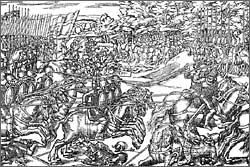
Another Derrick print from the same source showing the English (on left) defeating the Irish. In the foreground "Northern Horse" in mail charge the typical Irish cavalry who are very well depicted (including their method of using spears). In the background a "pyper" lies dead, while axe-armed Gallowglasses run away from English arquebusiers. (British Library)
|
Tyrone's Army
Hugh O'Neil, Earl of Tyrone, created the first really effective Irish army of the period, using as a nucleus Irish infantry he had kindly offered to train for Queen Elizabeth, and senior officers who had served in the English or Spanish armies. He raised 6,000 disciplined Irish foot, organized in companies of 100 and regiments probably 500 strong, with drums, bagpipes and colors, and armed with matchlock muskets and pikes (the musket bullets were made out of lead imported from England, ostensibly to re-roof O'Neil's castle of Dungannon). There were at least two musketeers to every pikeman, probably more.
Tyrone also reorganized the cavalry, equipping at least 300 "in the English fashion" with light lances and (presumably) stirrups; however, his cavalry, though good at harassing tactics, still could not stand up to the English in the open.
Generally, gallowglasses had become pikemen, kern musketeers, and dress and armour was probably little changed, though one of O'Neil's regiments wore red coats (probably his original troops for English service), and his men were said to have plenty of "graven murrions" (morions).
On the flanks of his "regular" forces, numbers of skirmishers with the older types of weapon operated, and there were also "New Scots", including Tyrone's own bodyguard of 200 musketeers.
Tyrone normally used harassing tactics in difficult country, but at the disastrous battle of Kinsale his forces drew up in the open in three large tercio-style blocks.
The Catholic Confederates
After the defeat of O'Neil and the crushing of his followers there was no war in Ireland until the 1640s, when Catholic uprising became confusingly involved with the Civil War situation in England. In the 1640s, Owen Roe O'Neill, the ex-commander of an Irish regiment in Spanish service, led the army of a Catholic Confederation (claiming loyalty to King Charles) to considerable success against Scots and Parliamentary armies. The "rebels" this time included both "Old Irish" and Anglo-Irish, and were armed largely by Spain and organized on Spanish lines. The Anglo-Irish would probably wear English-style coat, breeches and hose (just like any English Civil War troops; while many of the "Old Irish" might still be in traditional dress.
At the Irish victory of Benburb (1646) Owen Roe had seven infantry regiments; his own and that of Alexander MacDonnel were of 15 companies (1,500 men) and the rest of ten companies (1,000 men). They were made up about half and half of pikemen and musketeers, and drew up in the usual fashion with pike in the centre and shot on their flanks. The pikes were longer and smaller-pointed than British ones.
There were also nine troops of horse, some at least of them being lancers after the Spanish fashion.
Later, at Dungan's Hill, the Catholic army included four ox-drawn demi-culverins and 800 Scottish "Redshanks", armed chiefly with sword and targe. The Earl of Ormonde, who subsequently led all Royalist forces in Ireland, had among his Lifeguard a regiment of fusiliers with flintlock muskets.
About the Author
George Gush was educated at Tonbridge School, Kent, and won an Open Scholarship in History to Christ Church, Oxford, and has pursued a teaching career ever since graduation.
Acknowledgements
Article contents originally © Copyright George Gush and Patrick Stephens, Ltd 1975, 1982 and reproduced here with permission.
|
|

